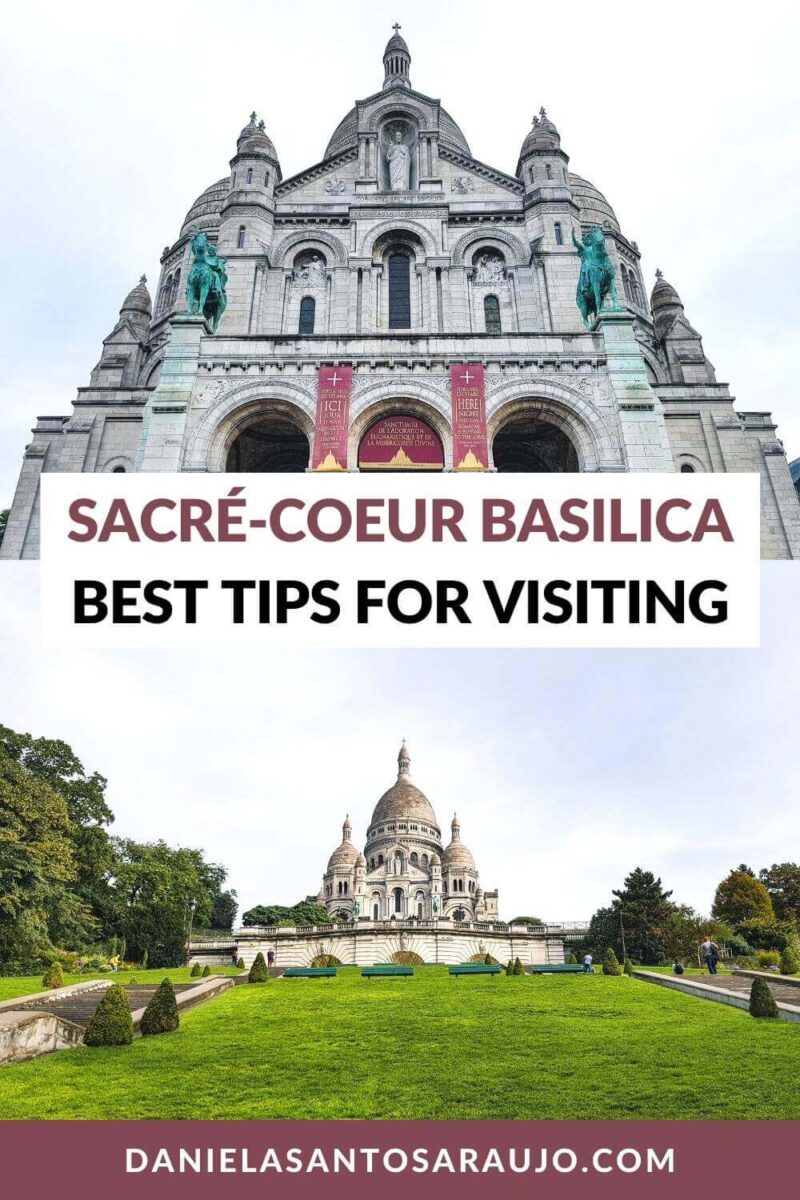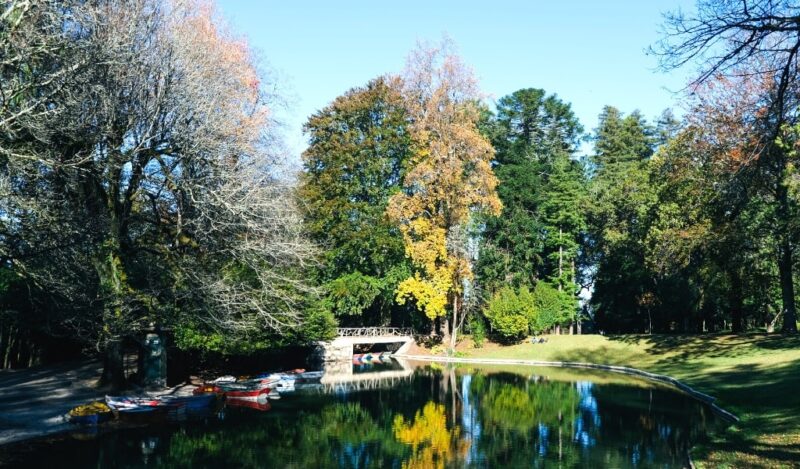The Sacré-Coeur Basilica (in French, Basilique du Sacré-Cœur) is one of the most visited monuments in Paris, with over 11 million annual visitors. Located in the Montmartre district, this basilica in travertine marble was projected by Paul Abadie and its construction took place between 1875 and 1914.
But did you know that the Catholic temple symbolizes a national penance in response to France’s defeat in the Franco-Prussian War? The French believed that the misfortunes arising in the conflict had spiritual causes and concluded that only a megalomaniac work like this could save the country!
So, do you want to know How To Visit The Sacré-Coeur Basilica In 2024? Keep reading!
This post may contain affiliate links, meaning I earn a small commission if you make a purchase, at no additional cost to you. Please read my disclosure & privacy policy for more information.
No time to read now? Pin it for later!


Brief History of the Sacré-Coeur Basilica
Few people know this, but the Basilica of the Sacred Heart is the fulfillment of a promise made by Alexandre Legentil and Hubert Rohault de Fleury in 1870! This is because that year, a conflict erupted between the French Empire and the Kingdom of Prussia (present-day Germany), which ended in a heavy defeat for France.
Now, these two men firmly believed that this tragedy had been a “divine punishment”, not because of the lack of military organization or political mismanagement, but because of successive sins and offenses against God. So, they swore to build a church dedicated to the Sacred Heart of Jesus, as a form of repentance.

In 1872, the Cardinal and Archbishop of Paris Joseph-Hippolyte Guibert approved this “National Vow” and chose the top of the hill of Montmartre – the highest point in the French capital – to build the temple. At that time, Montmartre was considered a sacred place, as it had been the scene of the first martyrdoms, in the 3rd century!
After the architect Paul Abadie won the competition to design the monument, work began on June 16th, 1875, and continued for four decades, always financed by donations. However, the Consecration of the Basilica took place only on October 16th, 1919, because of the First World War.
How to Get to the Sacré-Coeur Basilica
There are several ways to get to the Sacré-Coeur Basilica from the central and tourist areas and Paris, but the two simplest, cheapest, and more practical involve a combination of a metro ride with a short walk – or climbing.
Firstly, the Anvers station (on line 2) is about 500 meters from the Sacré-Coeur, although it involves climbing more than 200 steps of the Place Louise-Michel. If you prefer, you can opt for the Montmartre Funicular, whose entrance is on the left side of the square. The ticket for this climb/descent is the same as the metro.
The second alternative is to get off at Abbesses station (on line 12) and walk approximately 550 meters to the basilica. And when you arrive at Place Saint-Pierre, you only have to decide between the funicular and the steps, as in the first option.
Opening Hours & Ticket Prices
The Sacré-Coeur Basilica is open every day (for visits and/or prayer) from 6:30 am to 10:30 pm. With free entry, you’re likely to find queues or crowds of people, as the temple is visited by millions of tourists and pilgrims every year.
One of the most fascinating characteristics of the Sacré-Coeur is the fact that it has a “perpetual adoration” in front of the Blessed Sacrament, which began in 1885 and continues to this day without interruption! However, only people registered for the nightly adoration can attend the basilica after 11 pm.
What to See at the Sacré-Coeur Basilica
Façade of the Sacré-Coeur Basilica
For the construction of this basilica, Paul Abadie was inspired by two iconic monuments: St. Mark’s Basilica in Venice (in Italy) and the Hagia Sophia in Istanbul (in Turkey). Therefore, the architecture of the Sacré-Coeur is a mixture of these two religious buildings: the so-called Roman-Byzantine style.
Despite these strong foreign influences, the Sacré-Coeur Basilica has a series of nationalist elements, starting with the façade. For example, the two equestrian statues in bronze created by Hippolyte Lefèbvre in 1927, represent two important French saints: St. Louis and St. Joan of Arc.

On the pediment, you can admire two bas-reliefs: one of Mary Magdalene at Jesus‘ feet (by Léon Fagel and Louis Noël) and the other of Christ and the Samaritan Woman (by André d’Houdain). In the center, there’s also an image of the Sacré-Coeur, accompanied by a chicken and a pelican in high relief, symbols of God’s affection.
At the entrance, the three-arched peristyle is marked by three magnificent bronze doors (made by Lefèbvre too) and that depict biblical scenes related to the Sacred Heart of Jesus. The tympanums that crown each one of them describe similar episodes, but they’re by Léon Fagel.
Nave & Choir
The Sacré-Coeur Basilica has impressive dimensions: the Dome is 83 meters high and the Bell Tower reaches 84 meters!
Adding the elevation of Montmartre and the fact that the temple rests on a foundation of 83 pillars buried 33 meters deep, it’s easy to see why the Sacré-Coeur is the second tallest building in Paris – after the Eiffel Tower!

That said, you’ll need a few minutes to get used to the grandeur of the interior. So, start by sitting on one of the benches in the Nave and admiring the large dome that floods the space with light, with its 16 meters in diameter.
Then, notice the High Altar and the richly decorated structure of the Blessed Sacrament, the “heart” of the temple. Isn’t it stunning?
This area of the Apse is surrounded by the seats of the Choir and a masterpiece that covers the vault: the mosaic of “Christ in Glory”. Designed by three painters (Luc-Olivier Merson, Henri-Marcel Magne, and René Martin), it’s the largest mosaic in France and one of the largest in the world with a surface area of 475 m2!
Chapel of the Holy Virgin
The Deambulatory of the Sacré-Coeur is made up of seven chapels: three on the left side (Chapel of St. Ursula, Chapel of St. Ignatius of Loyola, and Chapel of St. Luke), three on the right (Chapel of St. Joseph, Chapel of St. John the Baptist, and Chapel of Saint Francis of Assisi), and the last one right behind the Main Altar: the Chapel of the Holy Virgin.

The most beautiful of these seven chapels has its own Dome, dated from 1907 and created by Henri-Marcel Magne. Both this mosaic and those of the various Virgins that decorate the walls have golden backgrounds, a clear Byzantine inspiration.
Another feature that distinguishes the Chapel of the Holy Virgin from the other six is the fact that it has a square plan – while the others are circular.
Parvis du Sacré-Coeur
The Parvis du Sacré-Coeur is the churchyard in front of the basilica, which you can explore before and/or after entering the monument. And if you visit it on a clear day, take advantage of the panoramic views to spot some of Paris’ most iconic buildings on the horizon. Here are some of them, from left to right:
- Gare du Nord | North Station
- Centre Georges Pompidou
- Cathédrale Notre-Dame de Paris | Notre Dame of Paris Cathedral
- Sainte-Chapelle de Paris | Holy Chapel of Paris
- Musée du Louvre | Louvre Museum
- Tour Montparnasse | Montparnasse Tower
- Musée d’Orsay | Orsay Museum
- Palais Garnier (or Opéra Garnier) | Garnier Palace (or Garnier Opera)
- Tour Eiffel | Eiffel Tower
- Arc de Triomphe | Triumphal Arch

Before leaving, make a complete tour of the Sacré-Coeur to admire other lesser-known views of the temple. Besides, it’s precisely at the back of the basilica that the Bell Tower is located, a tower with five bells designed by architect Lucien Magne and incorporated into the monument in 1904.
The oldest bell on the Campanile du Sacré-Coeur is its bourdon, which weighs 19 tons and is the biggest bell in France! Parisians nicknamed it the Savoyarde because it was offered by the French department of Savoie. The other four are much smaller and were transferred from another church in 1969.
Share this blog post on your social media!
More Posts about France
Gustave Moreau Museum: Best Tips For Visiting In 2024
Museum Of Romantic Life: Best Tips For Visiting In 2024
Marmottan Monet Museum: Best Tips For Visiting In 2024
More Posts about Religious Temples
4 Best Monasteries In Portugal (That You Should Visit This Year)
How To Visit The Sanctuary Of Sameiro In 2024
5 Best Sanctuaries In Portugal (That You Should Visit This Year)
What Photography Gear Do I Use?
- Camera Body: Fujifilm X-T4 Mirrorless
- Camera Lens: Fujinon XF 18-55 mm F2.8-4 R LM OIS
- Tripod: Manfrotto Compact Action
- Small Tripod: Manfrotto PIXI Mini
- Smartphone Adaptor: Manfrotto PIXI Clamp
- Memory Card: SanDisk 128GB Extreme PRO SDXC






